How do ya like the banner? Credit the esteemed Mr. Dw. Dunphy for the graphics honors.
Here we go again with Confessions of a Comics Shop Junkie, in which I opine on various recently released publications of the sequential graphic nature, some of which may be sitting on the rack at a comics shop, or awaiting the click of a button on some online merchant’s web page, near you. If you’re lucky. Or not, as the case may be.
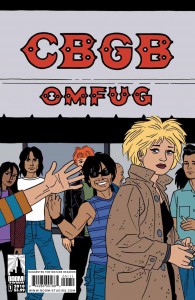 CBGB #1
CBGB #1
Scripts: Keiron Gillon, Sam Humphries; Art: Marc Ellerby, Rob G.; Cover: Jaime Hernandez
Boom! Studios, $3.99
When Punk hit as a movement, or a lifestyle, or whatever you want to call it, I was 16. Just the right age, it would seem, for me to recognize that the fat, bloated, dinosaur bands and their flaccid, fatuous music were overdue to be made redundant and a new, aggressive, more now kind of music and musicians were to be admired and identified with. The Ramones. The Pistols. The Damned. Television. Elvis Costello. The Clash. Et Cetera. Well…problem is, I didn’t admire or identify. 16 year old me, growing up in rural South Central Kentucky, really didn’t have much to rebel against and was perfectly happy with the music that many (not all) of those obsolete and irrelevant bands and musicians were making. Plus, all the spiky haircuts and torn leather jackets and safety pins and ghastly pale complexions just looked kinda silly to me. So, needless to say, I did not immediately gravitate to Punk or its subsequent successor New Wave music, no matter how hard my teenage bible Creem magazine tried to convert me. Eventually, though, I did stick my toe in the water in 1977, when I got curious enough after reading a feature article and a couple of reviews, to pick up the Ramones’ Rocket to Russia, and I loved it. Eventually, I’d go on to embrace Television and Tom Verlaine, Blondie, Talking Heads, Elvis C, even eventually the Clash (who were a real hard sell for a long time), to name a few- and looking back, I certainly recognize the validity of Punk as a movement, but remain dubious about what, if anything, was achieved.
But I know, you’re not reading this to find out about my personal history with Punk music, you want to know if this new comic from BOOM! entitled CBGB is any good. You want to know if it celebrates or illuminates the scene, as well as the place where it arguably gestated, the famous club in New York City. It’s made up of two stories; the first, by Gillen of Phonogram fame (so you know right off the bat that his head is in the right place) and Ellerby, is a Christmas Carol-inspired fantasy about a frustrated and obnoxious modern-day Punker who gets pissed at his bandmates and breaks up the group, then goes on a drunken pilgrimage to where CBGB’s used to stand. He falls down, hits his head, then comes to to find three spirits standing over him, prepared to give him the history of Punk as it began in NYC. Two claim to be the ghosts Punk past, one a Ramones-looking guy, the other looking like a stereotypical music critic. The future spirit, for his part, is more in the Dickensian mode. I suppose the idea is that perhaps the music press perpetuated the Punk legend as much as the actual musicians did, or at least that’s how I interpret it in more ways than one.
Anyway, what follows is a Cliff’s Notes run-through of some of the highlights, with the musicians’ names in bars obscuring their faces a la the Queen on the Pistols’ album. The Ghost of Future Punk’s message is a bit more obscure. All in all, very nicely done, quite informative. The second story, titled “The Helsinki Syndrome”, gives us a young punk in 1979 who’s forced to clean out the apartment of his recently deceased hermit uncle, who turns out to have been a musician who performed at the venue under the titular name two years earlier. Rob G, whose work I remember from The Couriers with Brian Wood for AiT/PlanetLar back in the day, has improved quite a bit since then, and does a great job of evoking the atmosphere of the place…at least as legend would have it.
For those of you who still have fond memories of the time and the place, you may want to check this out. It does a good, but not too reverent job of celebrating the legacy. I could easily have seen these stories being serialized in Creem, and that’s high praise as far as I’m concerned. (Reviewed from a PDF provided by the publisher)
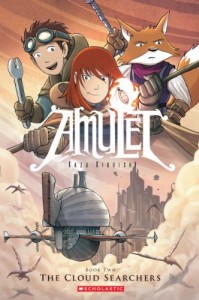 AMULET: THE CLOUD SEARCHERS
AMULET: THE CLOUD SEARCHERS
Script/Art: Kazu Kabuishi
Scholastic Graphix; Hardcover $21.99, Paperback $10.99. Release date: September 2010.
I can’t keep up with everybody, believe it or not, and despite being an admirer of the winning work of Kazu Kabusihi, I haven’t read everything he’s done (you may recall I reviewed his collection of Copper webcomics right here at this very website, in one of the first CoCSJs). So it’s not surprising (but a little disappointing, ’cause I try to keep up with this stuff) that I didn’t know about this GN series, aimed at preteens, which is now into its third issue! There’s nothing especially groundbreaking about this; it’s your basic “X stumbles into fantasy world, has adventures” scenario, with echoes of all kinds of stuff: Alice in Wonderland, Chronicles of Narnia, Lord of the Rings, Oz, Avatar, The Last Airbender, and so on and so forth…but I’m forgetting that the target audience for this series is not someone like me, who’s way too old and has seen enough of this sort of thing to be able to play “spot the influence”- it’s for that 9-12 year-old age group that hasn’t seen much of this (I think it’s safe to say that they’re probably familiar with many of these influences, via the movies if nothing else), and wants to get more. Kibuishi, with his likeably cartoonish and imaginative style, is just the person to give it to them, and this is lavishly illustrated to that effect. I must be honest at this stage and say that even though we get a recap (and Scholastic provided a supplementary brochure that also recapped this, as well as the rest of their Graphix line), it’s a bit difficult to follow who’s who and what this character’s relationship to that one is, things that can be (I’d imagine) easily remedied by getting the first two books in the series. But for me, on this particular volume, it took me a while to parse it all. If you’re thinking that this might be a great gift for your preteen or younger sister or brother, it will, no doubt about it- but be prepared to give the gift of the first two as well.
(Reviewed from an advance, uncorrected copy provided by publisher)
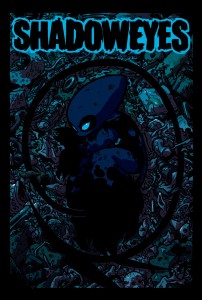 SHADOWEYES Vol. 1
SHADOWEYES Vol. 1
Script/Art: Ross Campbell
Slave Labor Graphics, $14.95
There’s something about Campbell’s otherwise (Corben-inspired? I’m guessing) technically solid art that’s just kind of odd and somewhat repulsive to me- his mixed-ethnic, kewpie-doll-featured people, all decked out in their chic punky hairstyles, big, mooncalf eyes, and bowtie, pouty lips- even on the men sometimes- just rubs my eyes the wrong way. So I’ve pretty much avoided his output whenever possible, except for the graphic novel Water Baby that he did for DC’s short-lived Minx imprint, which I really didn’t care for at all- but in all fairness it was more for story reasons than visual reasons, for once. This, however, is a somewhat different kettle of fish, and it’s a lot better than I expected.
Set in yet another dystopian future society (“200x”, to be exact, though he should probably change that to “20xx”) full of decrepit buildings and piled-up garbage, “Shadoweyes” (and doesn’t that sound like a Curtis Mayfield song or something?) is a young girl named “Scout Montana”, who lives with her single, working mom. She’s friends with Kyisha, a taller, thinner girl (a rarity for Campbell), and together they assist the neighborhood watch, trying to help keep crime down. In the process of interrupting a mugging, Scout gets hit in the head with a tossed brick, and when she comes to, she soon discovers that she can morph herself into a “superhuman blue creature”, that looks like a cross between Samus from the Metroid games, a Smurf, and one of the little critters in Bone. Taking this mind-bending life change remarkably well, she names herself Shadoweyes and decides to strike out on her own, becoming a vigilante crimefighter, and applying her somewhat idiosyncratic ideas about who’s guilty and who’s innocent to the mix. She’s able to live this double life for a while, splitting time between her home and her mostly-absent mom and her ramshackle lair in another location, until she becomes stuck in alien form, unable to change back, and also (she thinks) unable to return home. At about this same time, a gnomish school bud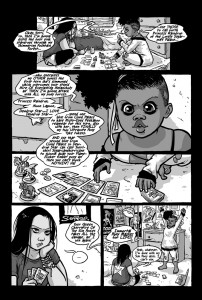 named “Sparkle Park”, who surely must be a direct descendant of one of the Campbell Soup Kids, comes up missing, the latest victim of a weird female-looking creature that lives and lurks in a garbage pile deep in the city (Shadoweyes had her own encounter with this Gollum-like creature earlier in the story). Her quest to find and rescue Sparkle, all the while trying to adjust to her new situation, makes up the second half (more or less) of the book.
named “Sparkle Park”, who surely must be a direct descendant of one of the Campbell Soup Kids, comes up missing, the latest victim of a weird female-looking creature that lives and lurks in a garbage pile deep in the city (Shadoweyes had her own encounter with this Gollum-like creature earlier in the story). Her quest to find and rescue Sparkle, all the while trying to adjust to her new situation, makes up the second half (more or less) of the book.
Campbell’s art, overall, is quite impressive here when you take away his near-fetishistic figure drawings- this city, named “Dranac”, is rendered with remarkable detail- debris and cables and shabby-looking people everywhere- and he does the occasional burst of action, with staccato layouts and exaggerated perspective, very well. Story-wise, I kept having to fight the urge to nit-pick; let’s just say that everyone concerned seems to be able to accept the freakiest of situations with remarkable ease and let it go at that. Also, Campbell keeps 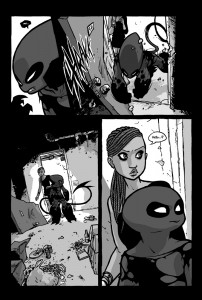 introducing tidbits about the characters with little or no setup beforehand- oh, by the way, this one’s transgendered! This one has terminal cancer! and so on. Sometimes the cause-and-effect in the dialogue comes across a bit wonky as well- perhaps he intends this to sound like “naturalistic” dialogue, but I kept getting a disconnect from time to time.One thing I did like was the dynamics of all the multiple interpersonal relationships between the characters- Scout and her mom, Scout-as-Shadoweyes and Sparkle (as well as her mom), Kyisha and her equally-androgynous boyfriend Noah…these become, as the story goes on, part of the focus and come across as feeling true and natural, dialogue issues aside.
introducing tidbits about the characters with little or no setup beforehand- oh, by the way, this one’s transgendered! This one has terminal cancer! and so on. Sometimes the cause-and-effect in the dialogue comes across a bit wonky as well- perhaps he intends this to sound like “naturalistic” dialogue, but I kept getting a disconnect from time to time.One thing I did like was the dynamics of all the multiple interpersonal relationships between the characters- Scout and her mom, Scout-as-Shadoweyes and Sparkle (as well as her mom), Kyisha and her equally-androgynous boyfriend Noah…these become, as the story goes on, part of the focus and come across as feeling true and natural, dialogue issues aside.
Anyway, all in all, though, this might be the most interesting thing I’ve ever read from Campbell (what his fans think I can’t say), and it might be a good entry point for those uninitiated in his work. I hope he revisits this world and these characters again. If you’re curious, he’s been serializing it on the Shadoweyes webpage, you can see enough there to tell if it’s for you or not. (Reviewed from a copy provided by the publisher)
Short takes will return next week. Lots of stuff going on in the comics world, as we had “Nerd Prom” last weekend, aka the San Diego ComiCon…I didn’t attend myself (maybe someday they’ll open up the huge Uncle Scrooge-like vault at Popdose HQ and send me out there- I won’t stand on one leg waiting) but I did keep up with all the news via Twitter and the many news sources available on the Web. As usual, let me point you to Heidi MacDonald and Tom Spurgeon‘s coverage. As SDCC’s become mostly a multi-media phenomenon, most of the biggest news was on the movie front, with the Scott Pilgrim, Thor, Green Lantern, and Avengers flicks taking center stage. It’s interesting that Fantagraphics is going to be collecting and republishing Floyd Gottfredson’s Mickey Mouse; I recall reading some of those as a kid via reprint and I remember them as being every bit as good as the more celebrated Barks Duck tales. I also noted that Marvel will be giving new life to the titles that were published under the recent and short-lived CrossGen imprint; I only read one of them with any interest at all, and fail to see how this will catch on any better than other attempts to revive dead comics lines (DC’s recently-killed MLJ line, Dark Horse’s jury-still-out Gold Key) have. We will see. The Eisner Awards were presented; I was delighted to see that Mike Kaluta, who’s been a favorite of mine for a long time, was selected for the Eisners Hall of Fame. About time.
The CoaCSJ Review Writing Playlist for this week: The Best of Waylon Jennings (RCA, 1970); Eels- Hombre Lobo; I Am Shelby Lynne; Nick Drake- Bryter Layter; Rolling Stones- Goat’s Head Soup; James Taylor- In the Pocket; Los Lobos- Colossal Head, Adrian Belew- Mt. Music Head.
That’s it for this week- thanks for reading, and see you next time, I hope.
Review inquiries, love letters, random acts of kindness- johnnybacardi AT gmail.





Comments